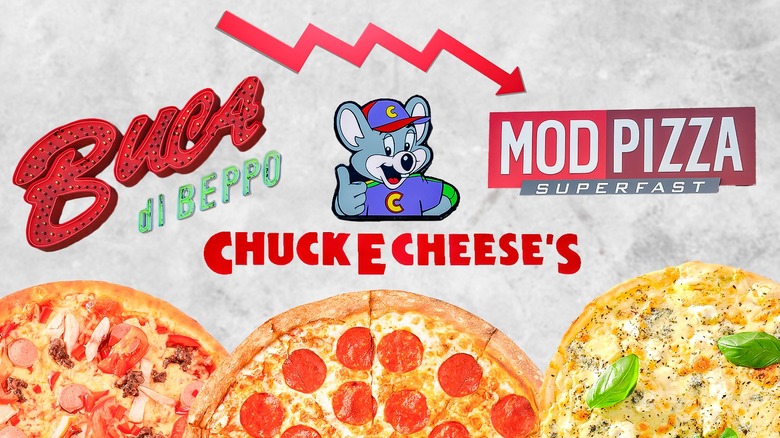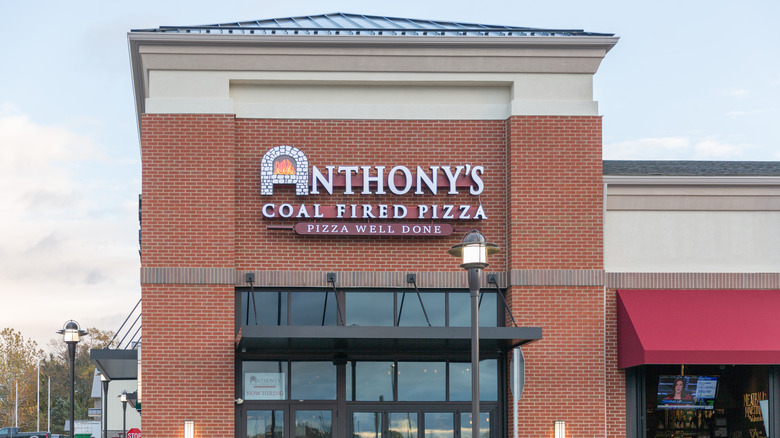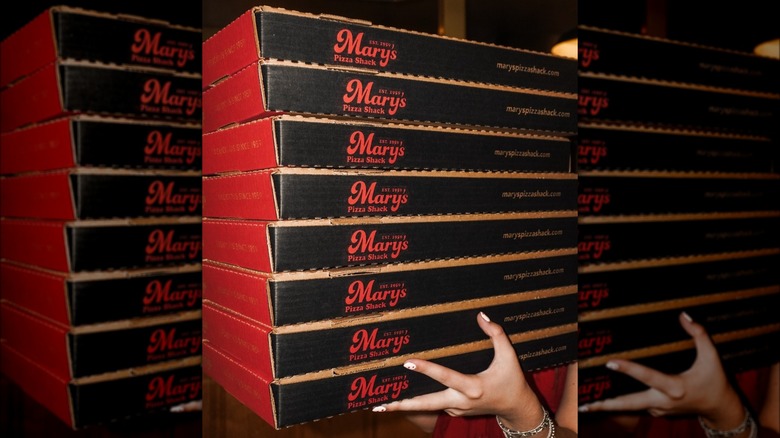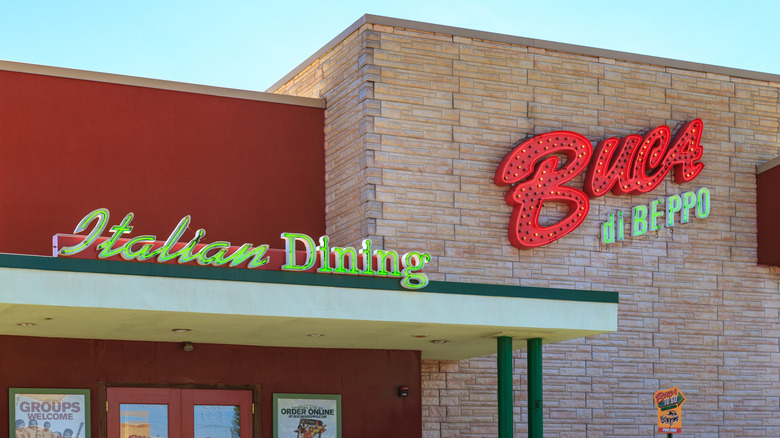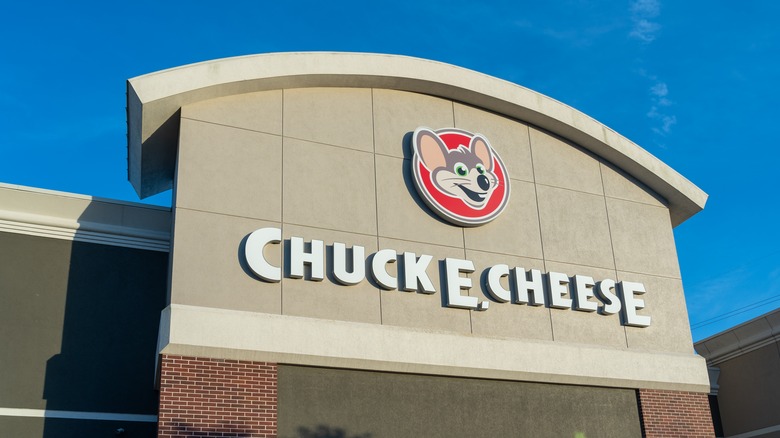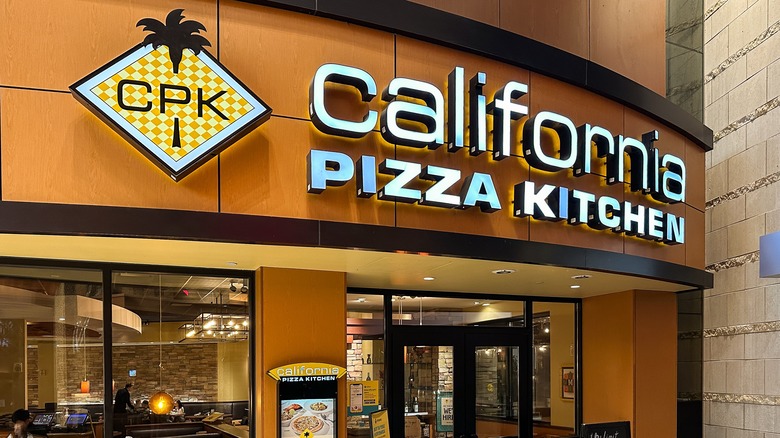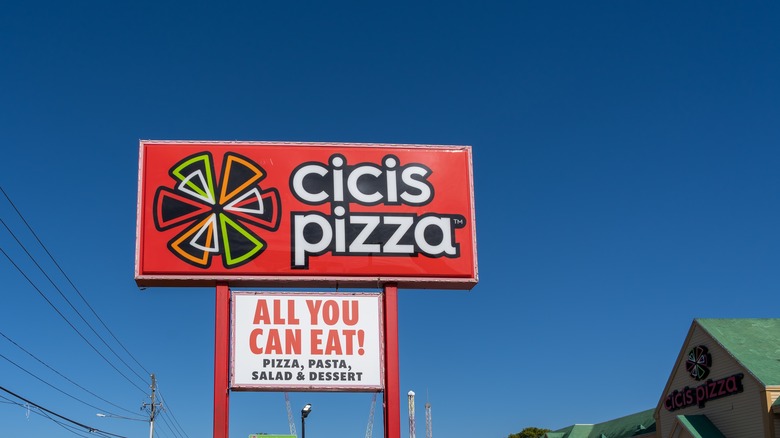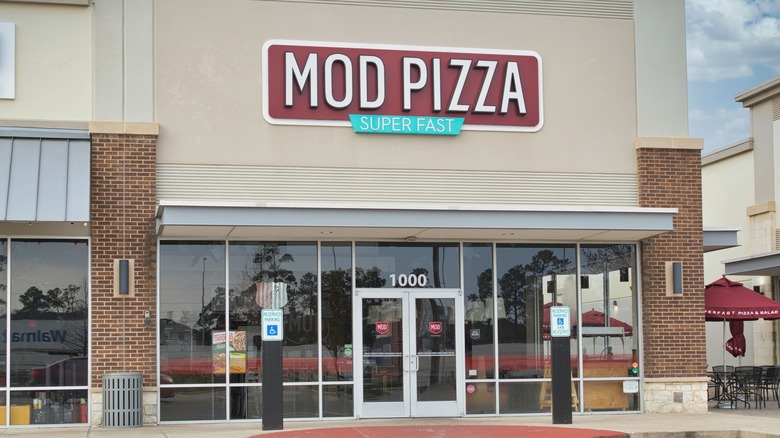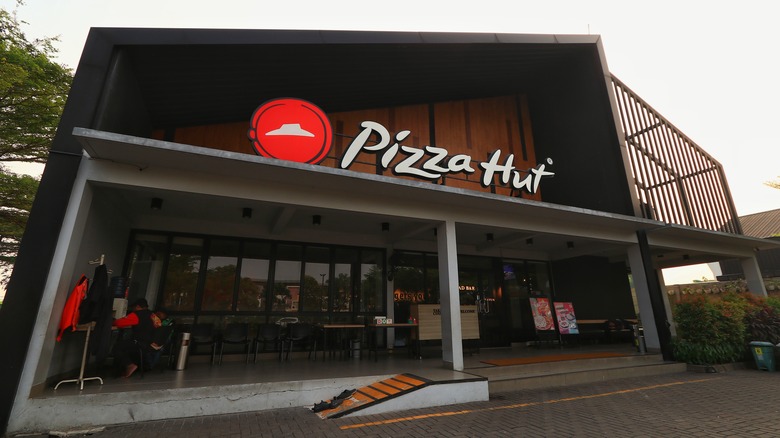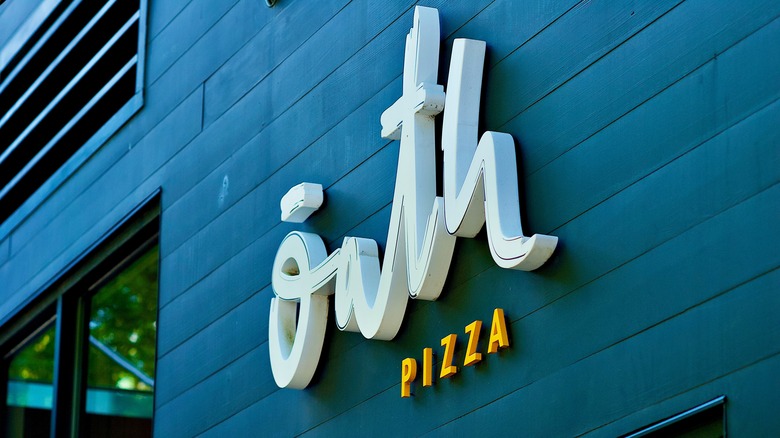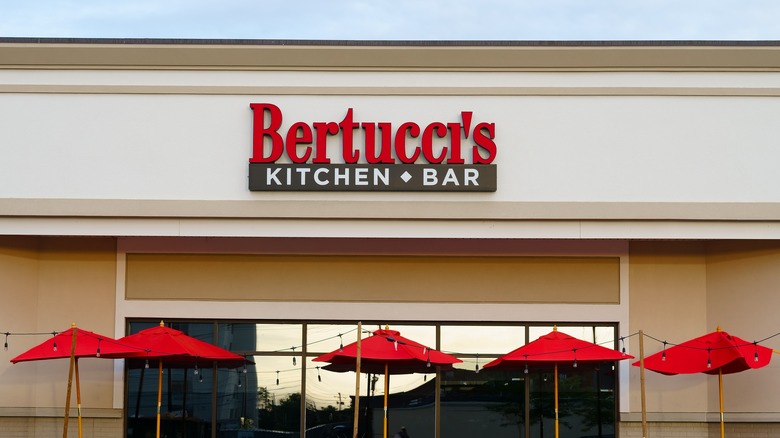Popular Pizza Chains That Have Recently Filed For Bankruptcy
Despite the fact that pizza will never go out of style, pizza restaurants have started to buckle under the weight of financial struggles. Though this trend of restaurants filing for Chapter 11 bankruptcy protection has been ripping its way through several popular restaurant brands, it's starting to impact pizza restaurants specifically as of late — and no, it's not because they don't keep their restaurants tidy.
Like other chain restaurants in their market, pizza restaurants are sinking further into debt as they frantically try to regain the stability that was lost during the pandemic lockdowns. Though pizza continues to be one of the most popular types of fast food in the country, it seems like the pizza purveyors in the fast-casual market are getting hit the hardest. After all, there's a reason that Costco is one of the most popular pizza chains in the U.S.
Regardless of how popular pizza is to American diners, several well-known national pizza chains have recently filed for bankruptcy or have been on the brink of doing so. Some of them have undergone financial restructuring and are seeing some positive numbers, but others have not been so fortunate. While the pizza-throwing future of these brands has yet to be seen, here are a few well-known restaurants that recently turned their playbooks to Chapter 11.
Anthony's Coal Fired Pizza & Wings
Popular along the East Coast, Anthony's Coal Fired Pizza & Wings was eventually acquired by BurgerFi, a Florida-based burger company that operates around 120 locations nationwide. As the restaurant's name implies, Anthony's made a name for itself with its coal-fired pizza ovens that helped give its pizza crusts a crispier texture, much more akin to New York-style pies. With the news that BurgerFi recently filed for bankruptcy amid financial losses of over $18 million, Anthony's has also been impacted.
According to a recent press release from BurgerFi, Chief Restructuring Officer Jeremy Rosenthal attributed the decision to a "drastic decline in post-pandemic consumer spending amidst sustained inflation and increasing food and labor costs." During the organization's period of financial restructuring, it sounds like most locations of Anthony's and BurgerFi will remain open for business, though BurgerFi did close 19 underperforming stores as the result of their financial struggles.
While the future is still uncertain for Anthony's and BurgerFi, company leadership is looking to reinvigorate the menus, address employee turnover issues, and an ongoing evaluation of its business model.
Mary's Pizza Shack
Moving over to the West Coast, we have Mary's Pizza Shack, a popular Bay Area pizza parlor that has been in business for over 60 years, which puts it close to some of the oldest pizza joints in the country. Mary's recently announced its decision to file for bankruptcy after financial struggles caused the company to close three locations. Per the company's press release, this decision is being met with optimism as it reshuffles the organization into smaller, "family-owned units" as opposed to their previous model which functioned as a single corporation.
Throughout its many years in business, Mary's Pizza Shack has been an enthusiastic contributor to local schools and nonprofits. This community-minded perspective along with the restaurant's classic pizza, pasta, and salad recipes have turned Mary's into a well-known fixture of the Bay Area.
In contrast to some of the other pizza restaurants on this list, Mary's is filing for Chapter 7 bankruptcy, which implies a plan to pay off its current debts by liquidating current assets. Mary's doesn't plan on closing any more locations as it navigates the bankruptcy process.
Buca di Beppo
Buca di Beppo's international presence made for a high-profile news story when it recently filed for bankruptcy. According to Restaurant Business Magazine, Buca di Beppo has closed 30 restaurants amid the bankruptcy filings. William Snyder, chief restructuring officer for Buca di Beppo, cited pandemic lockdown restrictions as the main reason for the restaurant's financial difficulties. Restaurant Business Magazine also reports that Buca di Beppo's liabilities where somewhere between $10 million and $50 million.
Buca di Beppo started out with one location in Minneapolis, but its family style service model, "more-is-more" take on wall art, and surprisingly good chicken Parmesan started to catch on with the locals. Though Buca di Beppo maintained its popularity for a number of years, this recent bankruptcy filing isn't the first of the company's woes. Before the restaurant was acquired by Planet Hollywood, the SEC investigated an alleged earnings management scheme carried out by the restaurant's former CEO and CFO.
Buca di Beppo continues to operate 44 locations with plans to open one more. According to a press release, Buca di Beppo president Rich Saultz is optimistic about the restaurant's current situation, and remains "enthusiastic about entering this next phase."
Chuck E. Cheese
While Chuck E. Cheese filed for bankruptcy, it is one of the national pizza restaurants on this list to officially leave bankruptcy behind. Shortly after filing for bankruptcy, David McKillips stepped in as CEO of CEC Entertainment, which is Chuck E. Cheese's parent company. According to a Nation's Restaurant News article, Chuck E. Cheese emerged from bankruptcy with $705 million of its debt paid off, leaving the restaurant with $100 million to invest in the company's future. In an interview with D Magazine, McKillips discussed the restaurant's plans to renovate all of its 470 venues along with further plans to develop a Chuck E. Cheese game show.
Perhaps best known for its mascot Charles Entertainment Cheese — better known as Chuck E. Cheese to his pals — this pizza restaurant has been the backdrop to kids' birthday parties for decades. Its cast of animal characters, limitless pizza, and wide range of arcade games have established the restaurant as a kind of paradise for anyone under the age of 10. Based on recent reports, it's looking like Chuck E. Cheese will be around for many more birthday parties to come — though its slightly creepy animatronic band will likely be disappearing from most locations.
California Pizza Kitchen
Like Chuck E. Cheese, California Pizza Kitchen is bouncing back from its bankruptcy filing. According to Forbes, current CEO Jeff Warne has helped guide the company and rebuild the brand after California Pizza Kitchen emerged from bankruptcy. Part of Warne's plan moving forward is to invest in their existing customers, step up their marketing strategy, and help current franchisees open more locations. As one of the restaurants on the list that does more business from dine-in instead of takeout, California Pizza Kitchen's plan looks to emphasize that aspect of its brand by strengthening its current fanbase.
California Pizza Kitchen started out in Beverly Hills and over the years has built up a reputation for getting creative with its pizza toppings. Its Beverly Hills roots helped inform the restaurant's adherence to California-style pizza, and its seasonal offerings helped add variety to the restaurant's menu. Currently, California Pizza Kitchen has 184 locations, 29 of which are located outside the United States.
Cicis Pizza
Cicis Pizza is a Texas-based pizza restaurant that also recently emerged from bankruptcy after being sold to D&G Investors. According to Restaurant Business Online, the investment group acquired Cicis and its $82 million in debt before the restaurant filed for bankruptcy and converted the debt into equity during the sale process. Cicis Pizza has closed over 100 locations since it filed for bankruptcy, leaving over 300 locations still in operation.
Unlike the other pizza restaurants on the list, Cicis is an all-you-can-eat pizza buffet. In addition to featuring pizzas with several combinations of toppings, it also offers regional pizza styles like deep dish, thin crust, and stuffed crust. With a wide range of sauces and plenty of unconventional toppings, there is plenty of variety on display at Cicis. Since emerging from bankruptcy, Cicis has continued to focus on its dine-in service model despite the fact that pizza restaurants with similar models have been hit hard by pandemic economics.
MOD Pizza
When places like California Pizza Kitchen and Chuck E. Cheese were in the throes of bankruptcy, MOD Pizza was also rumored to be considering bankruptcy itself. With a recent acquisition by Elite Restaurant Group, however, MOD Pizza seems to have staved off these rumors. Elite Restaurant Group, which also owns Patxi's Chicago Pizza, Marie Callender's, California Greek, and Mimi's Cafe, has acquired 100% of MOD Pizza's equity and is thus in control of its financial future.
When MOD Pizza closed 44 restaurants to cope with financial struggles around the same time that several fast-casual pizza restaurants filed for bankruptcy, it was rumored to be on the verge of bankruptcy. Since being acquired by Elite Restaurant Group, however, MOD Pizza is focusing on refreshing its brand and improving its guest experience.
MOD — short for "made on demand" — Pizza set itself apart from other pizza restaurants by offering highly customized pies for their customers. Its service model allows customers to select everything from their crust, toppings and amount of cheese for dine-in or carryout–many of them even have drive-throughs. While many of these beloved brands are placing bankruptcy in the rearview mirror, it's tough to deny that fast-casual pizza spots are quickly seeing the need to adapt to a rapidly changing consumer landscape.
EYM Pizza
There was a time when EYM Pizza was one of Pizza Hut's most prolific franchisees, with some 140 stores under its stuffed-crust umbrella. According to Restaurant Dive, however, EYM Pizza was forced to sell 127 Pizza Hut locations in the wake of filing for Chapter 11 bankruptcy protection in 2024.
This sale of EYM's Pizza Hut units will primarily impact locations the company operated in Illinois, Indiana, Georgia, South Carolina, and Wisconsin. EYM Pizza has enlisted the services of National Franchise Sales (NFS) to manage the sale of these locations. According to NFS, the organization will be "identifying qualified buyers and facilitating the sale of these units, to maximize recovery for creditors and provide a path forward for the restaurants involved."
While Pizza Hut remains one of the most prominent savory-pie providers in the U.S. — though it's definitely not America's largest pizza chain — this mass sale of Pizza Hut locations is the most recent update in an increasingly checkered history between the pizza giant and EYM. Restaurant Dive reports that EYM Pizza filed a lawsuit against Pizza Hut in March 2024 for breach of contract, accusing the national pizza brand of "failing to remain competitive and not adapting to modern practices." Pizza Hut then countersued EYM, claiming that it was "one of its poorest performing franchisees."
Oath Pizza
With a reputation for community spirit and pizza crust seared in avocado oil, this fast-casual pizza chain was founded in 2015 and grew from its original location on Nantucket Island to rapidly gain popularity on the East Coast. Over the years, Oath Pizza opened a headquarters in Boston, where it used its popularity among college students to expand its locations into New York, Pennsylvania, and California.
However, the local news outlet Nantucket Current reported that Oath Pizza closed out 2023 by closing seven corporate locations amid legal troubles between investors and former CEO Andrew Kellogg. Nantucket Current also reported that Oath Pizza investors filed a lawsuit against Kellogg because he "took steps to fraudulently sell the company to himself, leaving investors high and dry."
Nation's Restaurant News reports that Oath Pizza declared Chapter 7 bankruptcy in October 2024, and "will be liquidating its assets one year after closing all of its corporate locations." NRN also reported that the restaurant chain "estimated that it had under $500,000 in assets, and was up to $50 million in debt."
Bertucci's
Founded in Massachusetts, Bertucci's closed its Swampscott location in late autumn 2024, leaving only 15 restaurants in its home state. According to CBS News, Bertucci's closed 15 restaurants after filing for bankruptcy in 2018. Later Bertucci's was acquired by Earl Enterprises, which also owns Planet Hollywood — one of the worst-ranked themed U.S. dining chains. However, Bertucci's filed for bankruptcy once again in 2022, followed by a wave of more restaurant closures.
Bertucci's was launched in 1981, and touts its use of brick ovens at every one of its restaurants. Despite its financial difficulties, Bertucci's still strives to provide handmade Italian specialties with contemporary flair, along a wide variety of signature pizzas. Though Bertucci's has closed several locations in New England, fans can still find eateries open in Delaware, Maryland, Pennsylvania, and Virginia.
As this pizza chain struggles to bounce back from the post-pandemic restaurant landscape, it's received mixed reviews on social media, though the closure of Swampscott's location is apparently no surprise among local commenters. Bertucci's restaurants may persist for now, but the brand is still struggling to find its footing.
